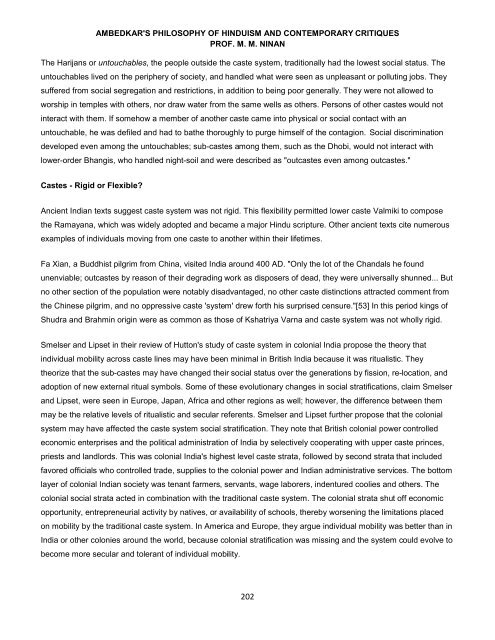Ambedkar-Philosophy of Hinduism
You also want an ePaper? Increase the reach of your titles
YUMPU automatically turns print PDFs into web optimized ePapers that Google loves.
AMBEDKAR'S PHILOSOPHY OF HINDUISM AND CONTEMPORARY CRITIQUES<br />
PROF. M. M. NINAN<br />
The Harijans or untouchables, the people outside the caste system, traditionally had the lowest social status. The<br />
untouchables lived on the periphery <strong>of</strong> society, and handled what were seen as unpleasant or polluting jobs. They<br />
suffered from social segregation and restrictions, in addition to being poor generally. They were not allowed to<br />
worship in temples with others, nor draw water from the same wells as others. Persons <strong>of</strong> other castes would not<br />
interact with them. If somehow a member <strong>of</strong> another caste came into physical or social contact with an<br />
untouchable, he was defiled and had to bathe thoroughly to purge himself <strong>of</strong> the contagion. Social discrimination<br />
developed even among the untouchables; sub-castes among them, such as the Dhobi, would not interact with<br />
lower-order Bhangis, who handled night-soil and were described as "outcastes even among outcastes."<br />
Castes - Rigid or Flexible?<br />
Ancient Indian texts suggest caste system was not rigid. This flexibility permitted lower caste Valmiki to compose<br />
the Ramayana, which was widely adopted and became a major Hindu scripture. Other ancient texts cite numerous<br />
examples <strong>of</strong> individuals moving from one caste to another within their lifetimes.<br />
Fa Xian, a Buddhist pilgrim from China, visited India around 400 AD. "Only the lot <strong>of</strong> the Chandals he found<br />
unenviable; outcastes by reason <strong>of</strong> their degrading work as disposers <strong>of</strong> dead, they were universally shunned... But<br />
no other section <strong>of</strong> the population were notably disadvantaged, no other caste distinctions attracted comment from<br />
the Chinese pilgrim, and no oppressive caste 'system' drew forth his surprised censure."[53] In this period kings <strong>of</strong><br />
Shudra and Brahmin origin were as common as those <strong>of</strong> Kshatriya Varna and caste system was not wholly rigid.<br />
Smelser and Lipset in their review <strong>of</strong> Hutton's study <strong>of</strong> caste system in colonial India propose the theory that<br />
individual mobility across caste lines may have been minimal in British India because it was ritualistic. They<br />
theorize that the sub-castes may have changed their social status over the generations by fission, re-location, and<br />
adoption <strong>of</strong> new external ritual symbols. Some <strong>of</strong> these evolutionary changes in social stratifications, claim Smelser<br />
and Lipset, were seen in Europe, Japan, Africa and other regions as well; however, the difference between them<br />
may be the relative levels <strong>of</strong> ritualistic and secular referents. Smelser and Lipset further propose that the colonial<br />
system may have affected the caste system social stratification. They note that British colonial power controlled<br />
economic enterprises and the political administration <strong>of</strong> India by selectively cooperating with upper caste princes,<br />
priests and landlords. This was colonial India's highest level caste strata, followed by second strata that included<br />
favored <strong>of</strong>ficials who controlled trade, supplies to the colonial power and Indian administrative services. The bottom<br />
layer <strong>of</strong> colonial Indian society was tenant farmers, servants, wage laborers, indentured coolies and others. The<br />
colonial social strata acted in combination with the traditional caste system. The colonial strata shut <strong>of</strong>f economic<br />
opportunity, entrepreneurial activity by natives, or availability <strong>of</strong> schools, thereby worsening the limitations placed<br />
on mobility by the traditional caste system. In America and Europe, they argue individual mobility was better than in<br />
India or other colonies around the world, because colonial stratification was missing and the system could evolve to<br />
become more secular and tolerant <strong>of</strong> individual mobility.<br />
202


















